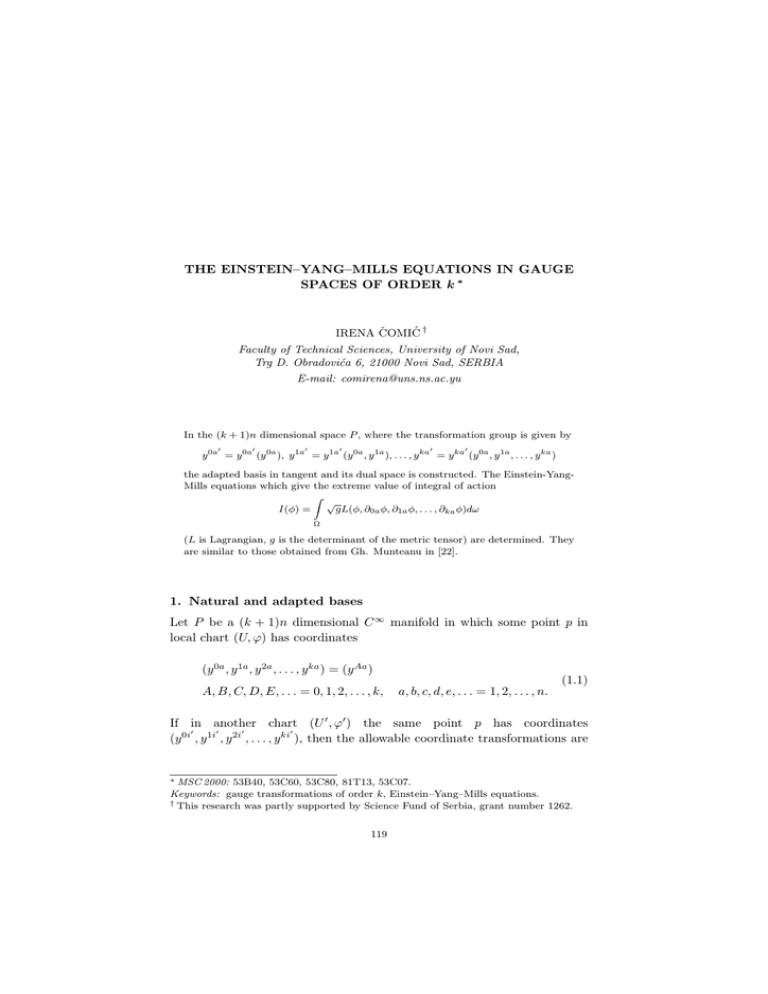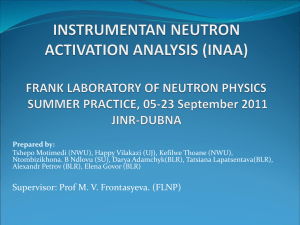THE EINSTEIN–YANG–MILLS EQUATIONS IN GAUGE k
advertisement

THE EINSTEIN–YANG–MILLS EQUATIONS IN GAUGE
SPACES OF ORDER k ∗
IRENA ČOMIĆ †
Faculty of Technical Sciences, University of Novi Sad,
Trg D. Obradovića 6, 21000 Novi Sad, SERBIA
E-mail: comirena@uns.ns.ac.yu
In the (k + 1)n dimensional space P , where the transformation group is given by
0
0
0
0
0
0
y 0a = y 0a (y 0a ), y 1a = y 1a (y 0a , y 1a ), . . . , y ka = y ka (y 0a , y 1a , . . . , y ka )
the adapted basis in tangent and its dual space is constructed. The Einstein-YangMills equations which give the extreme value of integral of action
Z
√
I(φ) =
gL(φ, ∂0a φ, ∂1a φ, . . . , ∂ka φ)dω
Ω
(L is Lagrangian, g is the determinant of the metric tensor) are determined. They
are similar to those obtained from Gh. Munteanu in [22].
1. Natural and adapted bases
Let P be a (k + 1)n dimensional C ∞ manifold in which some point p in
local chart (U, ϕ) has coordinates
(y 0a , y 1a , y 2a , . . . , y ka ) = (y Aa )
A, B, C, D, E, . . . = 0, 1, 2, . . . , k,
a, b, c, d, e, . . . = 1, 2, . . . , n.
(1.1)
If in another chart (U 0 , ϕ0 ) the same point p has coordinates
0
0
0
0
(y 0i , y 1i , y 2i , . . . , y ki ), then the allowable coordinate transformations are
∗
MSC 2000: 53B40, 53C60, 53C80, 81T13, 53C07.
Keywords: gauge transformations of order k, Einstein–Yang–Mills equations.
† This research was partly supported by Science Fund of Serbia, grant number 1262.
119
120
given by
0
0
0
0
0
0
0
0
y 0a = y 0a (y 0a ),
y 1a = y 1a (y 0a , y 1a ),
(1.2)
y 2a = y 2a (y 0a , y 1a , y 2a ), . . . ,
y ka = y ka (y 0a , y 1a , y 2a , . . . , y ka ).
Definition 1.1 The transformations of type (1.2) are called gauge transformations of order k.
The natural basis of T ∗ (P ) is
B̄ ∗ = {dy 0a , dy 1a , . . . , dy ka }.
(1.3)
Under the transformations of type (1.2) the elements of B̄ ∗ are transforming
in the following way:
0
0
0
0
ka0
ka0
dy 0a = (∂0b y 0a )dy 0b ,
0
dy 1a = (∂0b y 1a )dy 0b + (∂1b y 1a )dy 1b , . . . ,
dy
= (∂0b y
)dy
0b
+ (∂1b y
ka0
)dy
1b
(1.4)
+ · · · + (∂kb y
ka0
kb
)dy ,
where
∂Ab =
∂
,
∂y Ab
A = 0, 1, . . . , k.
If we introduce the notations:
0a0
dy
1a0
dy
Aa0
[dy ] = .
,
..
dy ka
dy 0b
dy 1b
[dy Bb ] = .
,
.
.
0
(1.5)
dy kb
0
∂0b y 0a 0
···
1a0
1a0
∂
y
∂
y
···
0b
1b
0
Aa
[JBb
] = .
..
0
0
0
0
∂0b y ka ∂1b y ka · · · ∂kb y ka
,
(1.6)
0
then (1.4) can be written in the form
0
0
Aa
[dy Aa ] = [JBb
][dy Bb ].
(1.7)
The elements of the Jacobian matrix are matrices of type n × n. If
0
Aa
rank[JBb
] = n(k + 1),
(1.8)
121
then exists inverse transformation of (1.2), which is the same type. The
identity transformation is the special case of (1.2) and where the composition is defined, the product of two transformations is also of type (1.2).
Theorem 1.1 The transformations of type (1.2) form a pseudo-group.
The natural basis of T (P ) is
B̄ = {∂0a , ∂1a , . . . , ∂ka }.
(1.9)
The elements of B̄ under transformations of type (1.2) are transforming as
follows:
0
0
0
∂0a = (∂0a y 0b )∂0b0 + (∂0a y 1b )∂1b0 + . . . + (∂0a y kb )∂kb0 ,
0
0
(∂1a y 1b )∂1b0 + · · · + (∂1a y kb )∂kb0 , . . . ,
∂1a =
(1.10)
0
(∂ka y kb )∂kb0 .
∂ka =
If we use the notations
[∂Aa ] = [∂0a ∂1a . . . ∂ka ],
[∂Bb0 ] = [∂0b0 ∂1b0 . . . ∂kb0 ],
(1.11)
then (1.10) can be written in the form:
0
Bb
[∂Aa ] = [∂Bb0 ][JAa
].
(1.12)
Remark 1.1 The transformations of type (1.2) are more general as those
in Osck M . The allowable transformations in Osck M are the special cases
of (1.2). The relations
0
0
0
∂y 0a
∂y 1a
∂y ka
=
=
·
·
·
=
,
∂y 0a
∂y 1a
∂y ka
0
∂y (A+B)a
=
∂y Ba
(1.13)
µ
¶
0
A + B ∂y Aa
,
B
∂y 0a
which are valid in Osck M ([6], [7]) in P are not valid in general case.
We shall construct the adapted basis
B ∗ = {δy 0a , δy 1a , δy 2a , . . . , δy ka }
(1.14)
of T ∗ (P ) in the following way:
δy 0a = dy 0a ,
1a
δy 1a = dy 1a + M0b
dy 0b ,
2a
2a
dy 0b , . . . ,
dy 1b + M0b
δy 2a = dy 2a + M1b
ka
ka
dy 0b .
δy ka = dy ka + M(k−1)b
dy (k−1)b + · · · + M0b
(1.15)
122
If we introduce the notations
a
0a
δb
0
0
δy
1a
a
M
δ
0
b
0b
δy 1a
M 2a M 2a δ a
Aa
Aa
1b
b
[MBb ] = 0b
[δy ] = .
,
.
..
.
.
δy ka
ka
ka
ka
M0b
M1b
M2b
··· 0
··· 0
··· 0
,
(1.16)
· · · δba
then (1.15) can be written in the form:
Aa
][dy Bb ].
[δy Aa ] = [MBb
(1.17)
Aa
MBb
in such a way, that the elements of
We shall determine the functions
∗
B =
{δy 0a , δy 1a , . . . , δy ka } are transforming in the following way:
0
δy
Aa0
=
Aa0
BAa
δy Aa ,
Aa0
BAa
∂y Aa
=
, A = 0, 1, . . . , k,
∂y Aa
(1.18)
no summation over A.
Remark 1.2 The transformation (1.18) is more general, then the corresponding formula
0
0
0
δy Aa = Baa δy Aa ,
0
Baa =
0
∂xa
∂y 0a
=
a
∂x
∂y 0a
in T ∗ (Osck M ), because in T ∗ (P ) (1.13) is not necessarily satisfied.
We have:
Theorem 1.2 The elements of the adapted basis B ∗ of T ∗ (P ) determined
Aa
by (1.17) satisfy the transformation law (1.18) if the functions MBb
are
transforming in the following way:
0
0
0
Aa
Aa
Aa
Bb
[BAa
][MCc
] = [MBb
0 ][JCc ], (no summation over A)
where
0
∂0a y 0a
0
···
1a0
0
∂
y
···
1a
Aa0
[BAa
]=
..
.
0
0
0
· · · ∂ka y ka
0
(1.19)
,
(1.20)
0
or in the explicite form
(A+B)a0
(A+B)a
B(A+B)a MAc
(A+B)a0
= MAb0
0
(A+B)a0
∂Ac y Ab + M(A+1)b0 ∂Ac y (A+1)b
(A+B)a0
0
0
(1.21)
0
+ · · · + M(A+B−1)b0 ∂Ac y (A+B−1)b + ∂Ac y (A+B)a .
123
Proof. Using (1.7), (1.17) and (1.18) we can write:
0
0
0
0
0
Aa
Bb
Aa
Bb
Cc
[δy Aa ] = [MBb
] = [MBb
],
0 ][dy
0 ][JCc ][dy
0
0
0
Aa
Aa
Aa
[δy Aa ] = [BAa
][δy Aa ] = [BAa
][MCc
][dy Cc ],
no summation over A. From the above two equations it follows (1.19).
From (1.2) and (1.19) it follows, that
(A+B)a
MAc
(A+B)a
= MAc
(y 0a , y 1a , y 2a , . . . , y (A+B)a ),
for 0 ≤ A ≤ A + B ≤ k.
We shall construct the adapted basis
B = {δ0a , δ1a , . . . , δka }
(1.22)
of T (P ) in the following way
kb
2b
1b
∂kb ,
∂2b − · · · − N0a
∂1b − N0a
δ0a = ∂0a − N0a
δ1a =
kb
2b
∂kb , . . . ,
∂2b − · · · − N1a
− N1a
∂1a
δka =
(1.23)
∂ka .
If we introduce the notations
[δAa ] = [δ0a δ1a . . . δka ],
[δAa0 ] = [δ0a0 δ1a0 . . . δka0 ],
δab
0 ··· 0
1b
−N0a
δab · · · 0
−N 2b −N 2b · · · 0
Bb
1a
0a
[NAa ] =
.
..
(1.24)
(1.25)
kb
kb
−N1a
· · · δab
−N0a
then (1.23) can be written in the form:
Bb
[δAa ] = [∂Bb ][NAa
].
(1.26)
Bb
We shall determine the transformation law of functions NAa
under conditions that the elements of B are transforming in the following way:
0
Aa
δAa = BAa
δAa0
A = 0, 1, 2, . . . , k,
(1.27)
no summation over A. (1.27) in the matrix form can be written as follows
0
Aa
[δAa ] = [δAa0 ][BAa
].
(1.28)
124
We have
Theorem 1.3 The elements of the adapted basis B of T (P ) satisfy the
Bb
are transforming in the
transformation law (1.27) if the functions NAa
following way:
0
0
0
Cc
Aa
Cc
Bb
[NAa
0 ][BAa ] = [JBb ][NAa ],
(1.29)
or in the explicite form
(A+B)a0
(A+B)c0
B(A+B)a NAa0
(A+B)b
= NAa
0
∂(A+B)b y (A+B)c +
(A+B−1)b
NAa
(B+1)b
NAa
0
∂(A+B−1)b y (A+B)c + · · · +
0
(1.30)
0
∂(B+1)b y (A+B)c − ∂Aa y (A+B)c .
Proof. From (1.12) and (1.23) and (1.28) it follows
0
Bb
Cc
Bb
[δAa ] = [∂Bb ][NAa
] = [∂Cc0 ][JBb
][NAa
],
0
0
0
Aa
Aa
Cc
[δAa ] = [δAa0 ][BAa
] = [∂Cc0 ][NAa
0 ][BAa ].
From the above two equations it follows (1.29).
From (1.29) and (1.30) we have
(A+B)b
NAa
(A+B)b
= NAa
(y 0a , y 1a , y 2a , . . . , y (A+B)a )
(1.31)
for 0 ≤ A ≤ A + B ≤ k.
Theorem 1.4 The necessary and sufficient condition that the adapted basis
B ∗ is dual to the adapted basis B, when B̄ ∗ is dual to B̄, i.e.
B b
[δy Bb ][δAa ] = δA
δa I
(1.32)
Bb
Aa
B b
[MAa
][NCc
] = δC
δc I.
(1.33)
is the following equation:
The explicit form of (1.33) is:
(A+B)b
NAa
(A+B)b
= MAa
(A+B)b
(A+B)b
(A+1)c
− M(A+1)c NAa
(A+2)c
M(A+2)c NAa
−
(A+B)b
(A+B−1)c
− · · · − M(A+B−1)c NAa
125
Proof. The substitution of (1.17) and (1.26) into (1.32) gives
Bb
Dd
[δy Bb ][δCc ] = [MAa
][dy Aa ][∂Dd ][NCc
]=
Bb A a
Dd
Bb
Aa
B b
[MAa
]δD δd I[NCc
] = [MAa
][NCc
] = δC
δc I.
Aa
Bb
] are inverse matrices.
] and [NCc
(1.33) means, that the matrices [MAa
Theorem 1.5 The elements of natural basis B̄ are connected with the elements of the adapted basis B in the following way:
Bb
[∂Aa ] = [δBb ][MAa
].
(1.34)
The explicit form of (1.34) is
kb
2b
1b
δkb ,
δ2b + . . . + M0a
δ1b + M0a
∂0a = δ0a + M0a
∂1a =
δ1a
kb
2b
δkb , . . . ,
δ2b + · · · + M1a
+ M1a
∂ka =
δka .
Aa
Proof. The multiplication of (1.26) with the matrix [MCc
] and (1.33)
results
Aa
Bb
Aa
B b
[δAa ][MCc
] = [∂Bb ][NAa
][MCc
] = [∂Bb ]δC
δc I = [∂Cc ].
The above equation is equivalent to (1.34).
Theorem 1.6 The elements of the natural basis B̄ ∗ are connected with the
elements of the adapted basis B ∗ in the following way
Aa
[dy Aa ] = [NBb
][δy Bb ].
The explicit form of (1.35) is
dy 0a = δy 0a
1a
dy 1a = δy 1a − N0b
δy 0b
2a
2a
dy 2a = δy 2a − N1b
δy 1b − N0b
δy 0b , . . . ,
ka
ka
dy ka = δy ka − N(k−1)b
δy (k−1)b − · · · − N0b
δy 0b .
Cc
Proof. The multiplication of (1.17) with [NAa
] and (1.33) results
Cc
Cc
Aa
C c
[NAa
][δy Aa ] = [NAa
][MBb
][dy Bb ] = δB
δb I[dy Bb ] = [dy Cc ].
The above equation is equivalent to (1.35).
(1.35)
126
Definition 1.2 Some tensor T in the space T (P ) ⊗ T ∗ (P ) is a d-tensor if
it can be expressed in the form
T = T AaBb δAa ⊗ δy Bb
(1.36)
and the components of T under (1.2) are transforming as follows
0
0
Aa
Bb
T AaBb0 = T AaBb BAa
BBb
0,
(1.37)
no summation over A and B.
This transformation is good defined, because
0
0
0
Aa
Bb
Bb
T = T AaBb0 δAa0 ⊗ δy Bb = T AaBb BAa
BBb
0 δAa0 ⊗ δy
0
= T AaBb δAa ⊗ δy Bb .
In the above equation (1.18) and (1.27) was used.
2. The Einstein-Yang-Mills equations in gauge spaces of
order k
The metric tensor in P is a symmetric, positive definite tensor of type (0, 2).
In the natural basis B̄ ∗ of T ∗ (P ), G has the form
G = ḡAaBb dy Aa ⊗dy Bb = [dy Aa ]T [ḡAaBb ]⊗[dy Bb ], (T − transposed ). (2.1)
From (1.35) we have
Bb
Aa T
[dy Bb ] = [NCc
][δy Cc ], [dy Aa ]T = [δy Dd ]T [NDd
] ,
so (2.1) can be written in the form
G = [δy Dd ]T [gDdCc ] ⊗ [δy Cc ] = gDdCc δy Dd ⊗ δy Cc
(2.2)
Aa T
Bb
[gDdCc ] = [NDd
] [ḡAaBb ][NCc
].
(2.3)
where
Let us denote by T0∗ , T1∗ , T2∗ , . . . , Tk∗ the subspaces of T ∗ (P ) generated by
{δy 0a }, {δy 1a }, {δy 2a }, . . . , {δy ka } respectively. If they are mutually orthogonal to each other with respect to the metric tensor G, then all blocks
in matrix [gDdCc ] for which D 6= C are equal to zero.
Theorem 2.1 The subspaces T0∗ , T1∗ , T2∗ , . . . , Tk∗ of T ∗ (P ) are mutually orthogonal to each other with respect to G, if and only if
G = g0a0b δy 0a ⊗ δy 0b + g1a1b δy 1a ⊗ δy 1b + · · · + gkakb δy ka ⊗ δy kb . (2.4)
127
Let L(y 0a , y 1a , . . . , y ka ) be a Lagrangian defined on the compact set
Ω ⊂ Rn(k+1) . As it is a scalar field we have
0
0
0
L(y 0a , y 1a , . . . , y ka ) = L(y 0a , y 1a , . . . , y ka ).
(2.5)
We shall suppose that the adapted basis B = {δ0a , δ1a , . . . , δy ka } are chosen
in such a way, that T0∗ , T1∗ , . . . , Tk∗ are mutually orthogonal to G, i.e. when
(2.4) is satisfied. We have
g = det|gAaBb | = det|g0a0b |det|g1a1b | . . . det|gkakb |.
(2.6)
and
0
0
Aa
Ab
gAaAb = gAa0 Ab0 BAa
BAb
, A = 0, 1, . . . , k.
(2.7)
From (1.6) it follows that the Jacobian matrix
0
0
Aa
[JBb
]=
0
0
D(y 0a , y 1a , . . . y ka )
D(y 0b , y 1b , . . . , y kb )
0
(2.8)
0
0
0a
1a
ka
is a triangle matrix which has blocks B0b
, B1b
, . . . , Bkb
on the main diagonal, so
0
0
0
0a
1a
ka
|J| = |B0a
||B1a
| . . . |Bka
|.
(2.9)
From (2.6) and (2.7) it follows
0
0
0
Aa
Ab
Aa 2
|gAaAb | = |gAa0 Ab0 ||BAa
||BAb
| = |gAa0 Ab0 ||BAa
| ,
A = 0, 1, 2, . . . , k.
(2.10)
The substitution of (2.7), (2.9) and (2.10) into (2.6) gives
g = det|gAaBb | = det|gAa0 Bb0 ||J|2 = g 0 |J|2 .
(2.11)
Let us define the Lagrangian density by
√
L(y 0a , y 1a , . . . , y ka ) = L(y 0a , y 1a , . . . , y ka ) g.
(2.12)
The substitution of (2.5) and (2.11) into (2.12) results
0
0
0 p
L(y 0a , y 1a , . . . , y ka ) = L(y 0a , y 1a , . . . , y ka ) g 0 |J|
= L(y
0a0
,y
1a0
,...,y
ka0
(2.13)
)|J|.
The elementary volume element dω in Ω under coordinate transformation
(1.2) is transforming in known way:
0
0
0
dω(y 0a , y 1a , . . . , y ka ) = |J|dω(y 0a , y 1a , . . . , y ka ).
(2.14)
128
Proposition 2.1 The integral of action
Z
I = L(y 0a , y 1a , . . . , y ka )dω
(2.15)
Ω
does not depend on coordinate system if and only if L(y 0a , y 1a , . . . , y ka )
satisfies the relation
0
0
0
L(y 0a , y 1a , . . . , y ka ) = |J|L(y 0a , y 1a , . . . , y ka ).
(2.16)
Proof. I is invariant if
L(y 0a , y 1a , . . . , y ka )dω(y 0a , y 1a , . . . , y ka ) =
L(y
0a0
,y
1a0
,...,y
ka0
)dω(y
(2.17)
0a0
,y
1a0
,...,y
ka0
).
The substitution of (2.14) into (2.17) results (2.16). The proof in the opposite direction is obvious.
From (2.12) and (2.13) we obtain that one example for L, which gives
coordinate invariant action is
√
L(y 0a , y 1a , . . . , y ka ) = gL(y 0a , y 1a , . . . , y ka ).
Proposition 2.2 For arbitrary C 2 function L(y 0a , y 1a , . . . , y ka ) the following relation is valid:
dL = (δ0a L)δy 0a + (δ1a L)δy 1a + · · · + (δka L)δy ka .
(2.18)
Proof. As L = L(y 0a , y 1a , . . . , y ka ) we have
dL = (∂0a L)dy 0a + (∂1a L)dy 1a + · · · + (∂ka L)dy ka .
(2.19)
The substitution of (1.34) into (2.19) gives:
1b
2b
kb
dL = (δ0a + M0a
δ1b + M0a
δ2b + · · · + M0a
δkb )Ldy 0a
+
=
+
(2.20)
2b
M1a
δ2b
0a
kb
(δ1a +
+ · · · + M1a
δkb )Ldy 1a + · · · + δka Ldy ka
1a
(δ0a L)dy + (δ1a L)(dy 1a + M0b
dy 0b ) + · · ·
ka
ka
(δka L)(dy ka + · · · + M1b
dy 1b + M0b
dy 0b ).
From (1.17) and (2.20) it follows (2.18).
We shall suppose that the Lagrangian L(y 0a , y 1a , . . . , y ka ), is the function
of φα (y 0a , y 1a , . . . , y ka ), ∂0a φα (y 0a , y 1a , . . . , y ka ), ∂1a φα (y 0a , y 1a , . . . , y ka ),
. . . , ∂ka φα (y 0a , y 1a , . . . , y ka ), where α = 1, 2, . . . , p.
129
For the simplification we shall consider only one function
φ = φ(y 0a , y 1a , . . . , y ka ) and use the abbreviations
∂Aa φ =
∂φ(y 0a , y 1a , . . . , ∂y ka )
, A = 0, 1, . . . , k.
∂y Aa
Now we have
L(y 0a , y 1a , . . . , y ka ) = L(φ, ∂0a φ, ∂1a φ, . . . , ∂ka φ)
√
= gL(φ, ∂0a φ, ∂1a φ, . . . , ∂ka φ)
and the integral of action has the form:
Z
I(φ) = L(φ, ∂0a φ, ∂1a φ, . . . , ∂ka φ)dω.
(2.21)
(2.22)
Ω
We are looking for such function φ, for which I(φ) has maximal or minimal
value, i.e. for which δI(φ) = 0.
For the simplicity we shall suppose that Ω is the (k + 1)n dimensional
rectangle, such that
0a
Z
1a
Zb
dω =
Ω
ka
Zb
dy
0a
a0a
Zb
dy ka ,
(2.23)
dy An , A = 0, 1, 2, . . . , k.
(2.24)
dy
1a
a1a
···
aka
where
Aa
A1
Zb
dy Aa =
aAa
A2
Zb
An
Zb
dy A1
aA1
b
Z
dy A2 · · ·
aA2
aAn
The variation of φ on the boundary of Ω is equal to zero, i.e.
δφ(b0a , y 1a , . . . , y ka ) = δφ(a0a , y 1a , . . . , y ka ) = 0, . . . ,
0a
δφ(y , . . . , y
(k−1)a
ka
0a
, b ) = δφ(y , . . . , y
(k−1)a
(2.25)
ka
, a ) = 0,
for a = 1, 2, . . . , n,
where for instance
δφ(y 0a , . . . , bA2 , . . . , y ka ) =
δφ(y 01 , . . . , y 0n , . . . , y A1 bA2 , y A3 , . . . , y An , . . . , y k1 , . . . , y kn ),
A = 0, 1, 2, . . . , k.
(2.26)
130
From the variation principle we have
Z
δI(φ) = δL(y 0a , y 1a , . . . , y ka )dω
Ω
Z ·
=
Ω
(2.27)
¸
∂L
∂L
∂L
δφ +
δ(∂0a φ) + · · · +
δ(∂ka φ) dω.
∂φ
∂(∂0a φ)
∂(∂ka φ)
From (2.21) it can be seen, that L is a function of independent variables
φ, ∂0a φ, . . . , ∂ka φ. To express this fact in (2.28) we shall write
dL
∂L
dL
∂L
=
,··· ,
=
.
∂(∂0a φ)
d(∂0a φ)
∂(∂ka φ)
d(∂ka φ)
(2.28)
From (2.18) it follows
L(φ, ∂0a φ, ∂1a φ, . . . , ∂ka φ) = L(φ, δ0a φ, δ1a φ, . . . , δka φ),
(2.29)
where (see (1.23)
1a
2a
ka
δ0b φ = ∂0b φ − N0b
∂1a φ − N0b
∂2a φ − · · · −
N0b
∂ka φ,
2a
ka
δ1b φ =
∂1b φ − N1b ∂2a φ − · · · − N1b ∂ka φ, . . . ,
δka φ =
∂ka φ.
(2.30)
We have
A0 =
dL
∂L ∂(δ0b φ)
∂L
=
=
d(∂0a φ)
∂(δ0b φ) ∂(∂0a φ)
∂(δ0a φ)
A1 =
dL
∂L ∂(δ0b φ)
∂L ∂(δ1b φ)
=
+
d(∂1a φ)
∂(δ0b φ) ∂(∂1a φ) ∂(δ1b φ) ∂(∂1a φ)
=
(2.31)
∂L
∂L
1a
− N0b
,
∂(δ1a φ)
∂(δ0b φ)
A2 =
dL
∂L
∂L
∂L
2a
2a
=
− N1b
− N0b
,
d(∂2a φ)
∂(δ2a φ)
∂(δ1b φ)
∂(δ0b φ)
A3 =
dL
∂L
∂L
∂L
∂L
3a
3a
3a
=
− N2b
− N1b
− N0b
,
d(∂3a φ)
∂(δ3a φ)
∂(δ2b φ)
∂(δ1b φ)
∂(δ0b φ)
....................................................................................................
Ak =
dL
∂L
∂L
∂L
ka
ka
=
− N(k−1)b
− · · · − N1b
d(∂ka φ)
∂(δka φ)
∂(δ(k−1)b )
∂(δ1b φ)
∂L
ka
− N0b
.
∂(δ0b φ)
131
We shall suppose, that
δ(∂0a φ) = (∂0a δφ), δ(∂1a φ) = ∂1a (δφ), . . . , δ(∂ka φ) = ∂ka (δφ).
(2.32)
From (2.28) and (2.31) we get
δL =
dL
dL
∂L
δφ +
δ(∂0a φ) +
δ(∂1a φ) + · · · +
dφ
d(∂0a φ)
∂(∂1a φ)
+
∂L
δ(∂ka φ) =
∂(∂ka φ)
(2.33)
=
∂L
δφ + A0 δ(∂0a φ) + A1 δ(∂1a φ) + · · · + Ak δ(∂ka φ)
∂φ
=
∂L
δφ + A0 ∂0a (δφ) + A1 ∂1a (δφ) + · · · + Ak ∂ka (δφ)
∂φ
=
∂L
δφ + ∂0a (A0 δφ) + ∂1a (A1 δφ) + · · · + ∂ka (Ak δφ)
∂φ
− (∂0a A0 )δφ − (∂1a A1 )δφ − · · · − (∂ka Ak )δφ.
Using (2.24) and (2.25) we have
1a
Z
2a
Zb
dy 1a
∂0a (A0 δφ)dω =
Ω
a1a
1a
Zb
dy ka
aka
∂0a (A0 δφ)dy 0a
a0a
ka
Zb
dy
a1a
dy 2a · · ·
2a
Zb
0a
Zb
a2a
1a
=
ka
Zb
Zb
dy
2a
···
a2a
¯b0a
dy ka (A0 δφ)¯a0a = 0.
In the similar way we obtain
Z
Z
∂1a (A1 δφ)dω = 0, . . . , ∂ka (Ak δφ)dω = 0.
Ω
(2.34)
aka
(2.35)
Ω
From (2.33)–(2.35) we obtain
¶
Z
Z µ
∂L
δI(φ) = (δL)dω =
− ∂0a A0 − ∂1a A1 − · · · − ∂ka Ak δφdω.
∂φ
Ω
Ω
(2.36)
132
The extreme value of integral of action is obtained when δL = 0. If we in
(2.36) substitute A0 , A1 , . . . , Ak from (2.31) we get
δL =
∂L
∂L
1b
kb
− (∂0a − N0a
∂1b − · · · − N0a
∂kb )
∂φ
∂(δ0a φ)
2b
kb
−(∂1a − N1a
∂2b − · · · − N1a
∂kb )
−(∂ka )
(2.37)
∂L
− ··· −
∂(δ1a φ)
∂L
+ B0 + B1 + B2 + · · · + B(k−1) ,
∂(δka )
where
B0 =
∂L
1a
2a
ka
[∂1a N0b
+ ∂2a N0b
+ · · · + ∂ka N0b
]
∂(δ0b φ)
B1 =
∂L
2a
3a
ka
[∂2a N1b
+ ∂3a N1b
+ · · · + ∂ka N1b
]
∂(δ1b φ)
B2 =
∂L
3a
ka
[∂3a N2b
+ · · · + ∂ka N2b
]
∂(δ2b φ)
B(k−1) =
∂L
ka
∂ka N(k−1)b
.
∂(δ(k−1)b φ)
Using (1.23) we have
Theorem 2.2 The extreme value of integral of action is obtained, when
δL = 0, i.e.
δL =
∂L
∂L
∂L
∂L
− δ0a
− δ1a
− · · · − δka
∂φ
∂(δ0a φ)
∂(δ1a φ)
∂(δka φ)
(2.38)
+ B0 + B1 + B2 + · · · + B(k−1) = 0,
In Osck M we have
(A+B)a
NAb
(A+B)a
= NAb
(y 0a , y 1a , . . . , y Ba ) ⇒
B1 = 0, B2 = 0, . . . , Bk−1 = 0.
(2.39)
(2.40)
Proposition 2.3 In Osck M the integral of action has extreme value if
δL =
∂L
∂L
∂L
∂L
− δ0a
− δ1a
− · · · − δka
+ B0 = 0. (2.41)
∂φ
∂(δ0a φ)
∂(δ1a φ)
∂(δka φ)
133
√
√
As from (2.19) we have L =
gL and g is not the function of
φ, ∂0a φ, ∂1a φ, . . . , ∂ka φ, so from (2.38) we obtain
Theorem 2.3 The Einstein-Yang-Mills equation for the gauge transformation of order k given by (1.2) expressed as function of the Lagrangian L
and the metric function g is given by
·µ
¶
∂
∂
∂
∂
√
δL = g
− δ0a
− δ1a
− · · · − δka
L
∂φ
∂(δ0a φ)
∂(δ1a φ)
∂(δka φ)
+
∂L
1a
2a
ka
[∂1a N0b
+ ∂2a N0b
+ · · · + ∂ka N0b
]
∂(δ0b φ)
+
∂L
2a
3a
ka
[∂2a N1b
+ ∂3a N1b
+ · · · + ∂ka N1b
]
∂(δ1b φ)
+
∂L
3a
ka
[∂3a N2b
+ · · · + ∂ka N2b
] + ··· +
∂(δ2b φ)
∂L
+
∂(δ(k−1)b φ)
·
−
(2.42)
¸
ka
∂ka N(k−1)b
¸
∂L
∂L
∂L
√
g = 0.
δ0a +
δ1a + · · · +
δka
∂(δ0a φ)
∂(δ1a φ)
∂(δka φ)
Proposition 2.4 In Osck M the integral of action has extreme value if
·µ
¶
∂L
∂L
∂L
∂L
√
δL = g
− δ0a
− δ1a
− · · · − δka
∂φ
∂(δ0a φ)
∂(δ1a φ)
∂(δka φ)
¸
∂L
1a
2a
ka
+
[∂1a N0b + ∂2a N0b + · · · + ∂ka N0b ]
∂(δ0b φ)
·
−
(2.43)
¸
∂L
∂L
∂L
√
δ0a +
δ1a + · · · +
δka
g = 0.
∂(δ0a φ)
∂(δ1a φ)
∂(δka φ)
Proof. The proof follows from Theorem 2.3 and equation 2.40.
References
1. G. S. Asanov, Finsler Geometry, Relativity and Gauge Theories, D. Reidel
Publ. Comp. 1985.
134
2. A. Bejancu, Fundations of direction-dependent gauge theory, Seminarul de
Mecanico, Univ. Timisoara, 13 (1988), 1–60.
3. A. Bejancu, Finsler Geometry and its application, Ellis Horwood series, New
York, London, Toronto, Sidney, Tokio, Singapore, 1990.
4. V. Balan, Gh. Munteanu and P. C. Stavrinos, Generalized Gauge Asanov
Equations on Osc2 M Bundle, Proceedings of the Workshop on Global Analysis, Differential Geometry and Lie Algebras (1995), 21–32.
5. I. Čomić, T. Kawaguchi and H. Kawaguchi, A theory of dual vector bundles and their subbundles for general dynamical systems of the information
geometry, Tensor Vol. 52, 286–300.
6. I. Čomić, J. Stojanov and G. Grujić, The Liouville vector fields in the subspaces of Miron’s Osck M In: Lagrange and Hamilton geometries and their
applcations, Radu Miron (ed.), Handbooks. Treatises. Monographs 49. Fair
Partners Publishers, Bucharest, 2004.
7. I. Čomić, G. Grujić and J. Stojanov, The subspaces in Osck M , Annalse Univ.
Sci. Budapest 48 (2005), 39–65.
8. I. Čomić, Curvature theory of generalized second order gauge connections,
Publ. Math. Debrecen 5041-2 (1997), 97–106.
9. I. Čomić, Generalized second order gauge connections, In: Proc. 4th Internat.
Conf. of Geometry, Thessaloniki 1996, 114–128.
10. S. Ikeda, On the second-order gauge transformation in the Finslerian gravitational field, Tensor N.S. 56 (1995), 301–305.
11. S. Ikeda, Some generalized connection structures of the Finslerian gravitation
field II, Tensor N.S. 56 (1995), 318–324.
12. R. Miron and Gh. Atanasiu, Compendium sur les espaces Lagrange d’ordre
superieur, Seminarul de mecanica, Univ. din. Timisoara, 1994.
13. R. Miron and M. Anastasiei, The Geometry of Lagrange Space, Theory and
Applications, Kluwer Acad. Publ., 1993.
14. R. Miron and Gh. Atanasiu, Differential Geometry of the k-Osculator Bundle,
Rev. Roum. Math. Pures et Appl., Tom XLI, No 3-4 (1996), 205–236.
15. R. Miron and Gh. Atanasiu, Higher Order Lagrange Spaces, Rev. Roum.
Math. Pures et Appl., Tom XLI No 3-4 (1996), 251–263.
16. R. Miron, The geometry of higher order Lagrange spaces, Applicationes to
mechanics and physics, Kluwer Acad. Publ., 1996.
17. Gh. Munteanu and Gh. Atanasiu, On Miron-connections in Lagrange spaces
of second order, Tensor N.S. 50 (1991), 241–247.
18. Gh. Munteanu, Metric almost tangent structure of second order, Bull. Math.
Soc. Sci. Mat. Roumanie, 34(1) (1990), 49–54.
19. Gh. Munteanu Gh and S. Ikeda, On the Gauge Theory of the Second Order,
Tensor N. S. 56 (1995), 166–174.
20. Gh. Munteanu, Techniques of higher order osculator bundle in generalized
gauge theory, In: Proc. of Conf. on Diff. Geom. and Appl. Brno, 1995, 28–30.
21. Gh. Munteanu, Lagrangian Gauge Theory of Superior Order, In: Proc. Math.
Seminar, Univ. Brasov, 1996.
22. Gh. Munteanu, Higher order Gauge-invariant Lagrangians, Novi Sad J.
Math. Vol. 27, No. 2 (1997), 101–115.








